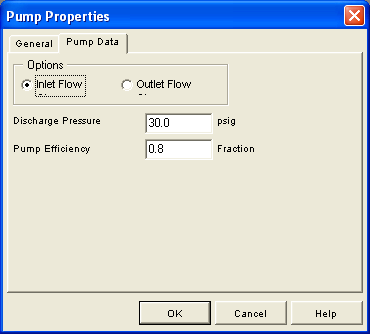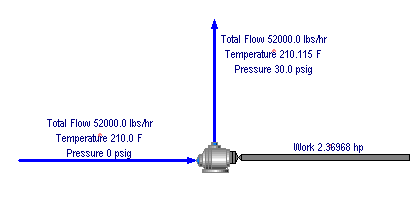|
The Pump simulates an adiabatic pump by boosting stream pressure to a set discharge pressure and calculating the shaft work required.
The pump efficiency is actually a mechanical efficiency and dictates how much of the shaft work energy is added to the fluid by mechanical heating.
|
What do you want to see?
|
 |
Data Description
|
Data |
Unit |
Description |
|
Set |
Item |
Type |
Native |
|
Equipment Properties |
InletGiven |
|
|
If checked (True) the outlet total flow is set to the inlet total flow. If not checked
(False) the inlet flow is set to the outlet flow. |
|
Discharge Pressure |
Pressure |
psia |
Outlet stream pressure. |
|
Pump Efficiency |
Fraction or Percent |
Fraction |
Efficiency |
If the Discharge Pressure is less than or equal to the inlet pressure an error is issued and the outlet pressure is set to the inlet pressure.
The outlet enthalpy is calculated as:
houtlet = hinlet + ( vinlet * ( Poutlet - Pinlet ) * 144.0 * 0.0012854 ) / Effpump
The shaft work is calculated as:
Wshaft = Finlet * ( houtlet - hinlet )
where:
Wshaft is the shaftwork, BTU/hr
Finlet is the inlet flow, lbs/hr
houtlet is the outlet enthalpy, BTU/lb
hinlet is the inlet enthalpy, BTU/lb
vinlet is the inlet specific volume, ft3/lb
Poutlet is the outlet pressure, psia
Pinlet is the inlet pressure psia
144.0 is the conversion from in2 to ft2
0.0012854 is conversion from ft-lbf to BTU
Effpump is the pump efficiency
Outlet temperature is calculated from the outlet pressure, enthalpy and composition.
Solution: check if all the streams are connected to the equipment.
Solution: Set outlet pressure higher than the inlet pressure.
Solution: Set liquid inlet flow.






 Errors
Errors
